Epilogue
The Cooler Master X Silent Edge 1100W is an interesting product. It is the strongest passively cooled PSU available on the market today, thanks to an advanced cooling system with heatpipes that its chassis incorporates. This PSU is entirely made by CM’s team, both design and production and this is impressive, given that it is not as easy as it sounds to design your own PSU platform and also build it. The design is weird, though, to say the least. Given the pair of MCUs that I found at its internals, I expected a semi-digital design, the least, but I found instead analog controllers in every vital circuit. Having the digital controllers in place doesn’t say much if you don’t have the corresponding firmware, and this is CM’s next goal: to fully utilize these controllers. However, from the moment they are not utilized fully in this PSU, they could be omitted, vastly lowering the production cost.
Although the X Silent Edge achieves a top overall score, it feels to me that it is an intermediate stage to something great. Without any doubt, CM needs to work in this field to gain more experience, and this PSU is a stage towards the ultimate goal, which is to release a fully digital PSU. Other experienced OEMs didn’t even manage or simply didn’t want to make this step, but CM did that, and I respect its team for that. Back to the X Silent Edge, it scores top performance in some areas. Still, some performance factors need improvement, including the load regulation on the minor rails, efficiency at light and super-light loads, and especially the 12V rail’s transient response in ATX v3.1 scenarios, which are the toughest ones. Lower vampire power at 230V would be good, too.
During all test sessions, we didn’t encounter any coil whine issues, which are usually a major headache in passive PSUs, where there is no fan noise to cover them. The X Silent Edge performed amazingly well in this section, and since we always need dead silent PSUs for our hemi-anechoic chamber, it will probably replace the ones we currently use. If you are wondering, I didn’t test the PSU at 115V because its max power drops to 850W, which is still higher than everything available in the passive PSU market today. It would be a pain to have graphs of >1000W and 850W units at the same time; it would be like two separate reviews in one, leading to confusion in the end.
The Cooler Master X Silent Edge 1100W is not affordable; it currently costs 400 dollars, while its normal price is $510! The X Silent MAX 1300W, which is not fully passive, is more affordable at $459. The fact is that passive units are typically way more expensive than normal ones because of the technology involved and the RMA risk! CM also made a move that I don’t agree with, providing a crazy-long 15-year warranty to these units. I hope this doesn’t backfire on CM.
The Cooler Master X Silent Edge 1100W is the best-performing passively cooled PSU, meeting eye-to-eye units with active cooling. On top of that, it is by far the strongest passive unit available in today’s market. Yes, it needs further development and improvements in various sectors, and above all, it needs to get rid of all analog controllers and fully exploit its pair of MCUs. Still, I believe I will be wrong if I do NOT give it an editor’s choice. I am very strict with editor choice awards; I only provide this award on special occasions, and this is one of them. I hope CM continues the development of this platform and seriously considers my comments to improve it. It should also drop the ridiculously-long warranty period and provide something more down to earth.
Before investing in a new power supply, read my Best ATX v3.x PSUs article to check all alternative PSU offerings. You help me a lot by using my affiliate links, which don’t increase the product’s price. I get a commission from Amazon every time you do it, which can make a difference for me, especially now that I am on my own, working exclusively for my media and not for someone else.

- Delivered full power at 47°C
- Passively cooled (so no noise output)
- ATX v3.1 and PCIe 5.1 ready
- Top overall performance
- High average efficiency
- Highly efficient 5VSB rail
- Top build quality
- Good transient response at 12V (normal loads)
- Tight load regulation at 12V
- Good ripple suppression
- Extended hold-up time
- Extremely low inrush currents
- Conservatively set OCP and OPP triggering points
- Alternative Low Power Mode (ALPM) compatible
- Fully modular
- Many cables and connectors, including a high-power one (12+4 pin, 600W)
- Long enough distance (140mm) between the SATA connectors
- Not affordable
- Protection features need tuning for larger differences in the triggering points between hot and cold conditions
- 12V rail’s transient response needs to get better in ATX v3.1 test scenarios
- Efficiency needs boosting at light loads
- The 3.3V rail needs tighter load regulation and better transient response (normal loads)
- Increased vampire power
- Such a long warranty period will eventually create problems for both the brand and consumers




I don’t agree with the warranty criticism. It is stated definitively without proof:
“Such a long warranty period will eventually create problems for both the brand and consumers”
Will? How about “might”? It’s actually refreshing to see a company stand behind their product. 15 years is not an unreasonable lifespan for a PSU.
With low loads the efficiency is terrible, much worse than many psu that are around at better prices. Together with other shortcomings I honestly do not understand how it could have taken the editor choice…. incredible. They did not take much more performing power supplies.
why was my comment deleted?
Is it necessary to have a case that allows natural convection, that is, one that has an opening for airflow in the part above the PSU? For example, the be quiet! Dark Base Pro 901 is not compatible with this PSU because it does not have openings on the shroud top?
Yes, this is required else the hot air will be trapped inside the PSU.
Thanks for the review.
Now this in SFX 750-850w and it’s golden.
Even if i had to pay 300€ for a Fanless and no coil whine.
A lot of what makes this sort of thing possible is the somewhat large size, since smaller PSUs need to pack components more tightly which reduces their exposed surface area and therefore cooling potential. This is why SFX PSUs tend to be louder, because the fan needs to spin faster to account for this difference and keep components cool. In other words, less surface area needs more airflow to dissipate heat, while more surface area will need less; this is why passive CPU coolers like the Noctua NH-P1 are so huge, and why rack-mounted servers are able to have such small heatsinks for how power-hungry server hardware can be.
This isn’t to say that a passively cooled SFX unit is impossible, but rather that it would require a lot of development and would have a much lower capacity. After all, safety should be the number one thing when designing (and indeed buying) a new PSU.
honestly I don’t see the point (it’s a showoff most likely), to require as much power you’d need a Threadripper and probably two 4090, there’s no way to cool these down passively
what we need are affordable 400W Passive SFX models instead
We might not need 1100W necessarily, but the smaller 850W model is very welcome and I’ll be buying one of these two when they’re finally available.
I have a RTX 4090 PC with custom watercooling that is completely silent even under heavy load and currently the Seasonic 600W passive PSU. It’s a tad undersized, so I want to upgrade – but for now, the only upgrade path has been the 700W Seasonic. I’m not spending that much money on a 100W upgrade that’ll be useless when GPUs inevitably use the full 600W the new cable can provide.
I do not consider an actively cooled PSU an option because I have yet to see one that’s certain to not add noise to my system at full load.